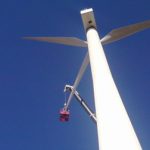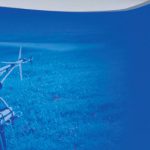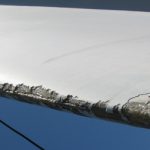The chaotic variability in wind speed, direction, shear, and turbulence makes monitoring and analyzing modern wind turbines a challenge. Wind operators must squeeze out every watt they can when the wind is blowing. To do so, wind projects must be reliable and maintained with minimum cost. With variable winds, high costs, and slim margins, everything has to work right to make sure that wind is an attractive alternative power and a sound economic investment. So if a turbine is to work 20 years or more before retiring, it had better be properly designed and maintained.
Traditional Procedures
Most wind turbines are maintained by a combination of traditional schedule-based preventive maintenance and threshold-based alarm systems. A problem with scheduled maintenance is that the standard six-month interval between inspections may be too long to detect an emerging problem. And fixed-threshold alerts, typically set by OEMs, activate too late to support proactive maintenance. That’s because the alerts are intended to protect equipment from catastrophic damage and can’t take into account a wide range of normal wind-turbine operating conditions and unit-to-unit manufacturing variances. As a result, typical fixed-threshold-alert systems do not detect problems until after a failure occurs.
Likewise, traditional condition-monitoring and predictive maintenance tools such as vibration analysis, oil analysis, and thermography are limited because of the difficulty in accessing the typical wind-turbine nacelle, the variable nature of the machine, and the time limitations and analytic capabilities of the technicians using them.
Ideally, equipment maintenance should only be performed when something needs fixing. Most preventive maintenance works on the idea of regularly inspecting or servicing equipment to address potential failures before they progress. However, given the huge variations in operating profile and environment, it’s easy to see that the regular, fixed inspection interval of traditional preventive maintenance may not catch critical emerging problems in the wind environment.
The conventional power industry, however, leads the industrial world in predicting impending equipment problems before they occur. And it is doing so using a technology directly applicable to the wind industry. In fact, several wind companies already use this technology to get early warnings, avoid surprises, and improve control of their operations. They reduce risk exposed by existing condition-monitoring tools and leverage SCADA data to remotely detect emerging problems by using SmartSignal predictive diagnostics.
Briefly, SmartSignal precisely identifies impending problems by detecting subtle changes in equipment operation. It finds problems earlier than OEMs’ alerting systems or other condition monitoring approaches, and well within traditional alarm limits.
SmartSignal Advantages
Recognizing that wind is unpredictable in predictable ways, SmartSignal predictive diagnostic software works by analyzing SCADA data once every five to 10 minutes. It compares real-time data to software models of equipment when operating in good condition and compensates for normal variations due to load and ambient conditions. Further, SmartSignal uses software models customized for individual pieces of equipment to provide the earliest possible warning of emerging problems. SmartSignal readily integrates with an existing data infrastructure, and it’s quick and easy to deploy, maintain, and use.
This method needs no new sensors, and analysts need not review masses of SCADA data. Instead the software analyzes data and alerts analysts only when it detects an exception, providing ample time to plan and respond. And by using algorithms to identify pattern changes, the analysis is highly accurate.
For wind applications the software uses models customized for each individual turbine, which compensate for fluctuations in wind speed, direction, and ambient conditions. In real time the software compares data collected in the nacelle to the models—literally tens of thousands of data points every five to 10 minutes across a fleet—and notifies maintenance and engineering of impending problems. Owners then focus on fixing problems early, before catastrophic damage occurs.
Take a gearbox, for example. During the initial system configuration a gearbox model would be “trained” using representative data provided from a data historian such as OSI PI (a data historian is a database for storing time-series data from instrumentation). Typically, one year of data would be used to train the model. In live operation data from relevant sensors on the gearbox such as for vibration and temperatures, along with operational state information such as power output and ambient temperature, would be compared to the model. The model would then provide an “estimate” of what each value should be, based on how it was trained from the historical data. If the actual value statistically differed from the model estimate, the system would generate an alert. Technicians would review the sensors in alert and develop a preliminary diagnosis of the problem. A next step would typically be further on-machine investigation or use of other techniques, such as oil sampling. Note that SmartSignal even provides a full-service solution, in which its own engineers monitor customer wind farms from SmartSignal’s in-house Availability and Performance Center (see Figure 1).
Competitive Edge
A recent Wind Energy Operations & Maintenance Report cited that approximately 79 percent of wind turbines in operation are still under warranty. That will soon change, leaving many owner-operators vulnerable to equipment failure. Gearbox reliability consistently falls short of OEM projections. Designed for a 20-year life, many gearboxes are failing after six to eight years of operation. O&M costs for wind power are exceptionally high in the United States, and often double or triple budgeted projections.
Given the high capital intensity of the wind-power business reliable, long-term operation of the equipment is critical for generating positive returns and continued industry growth. It won’t take many major equipment failures before the long-term profitability of a farm is lost. As assets age, performing major work only when needed will be critical to maintaining economic viability.
Remote monitoring and condition-based maintenance approaches will be required to maintain financial returns because wind turbines are hard to access and don’t receive the same “walk-around” monitoring typical of industrial plants. Although wind has unique characteristics, wind turbines are just another kind of machine and successful operators will take advantage of best practices from other industries to outstrip their competition.
Efficient wind-farm management presents distinct monitoring challenges. Schedule-based maintenance and other traditional techniques have been ineffective in the dynamic environment of wind generation. Ambient conditions vary widely, and wind turbines don’t offer a constant load but rather cycle up and down, presenting a unique wind regimen and set of data points. Each turbine has 60 or more analog sensors, with data reporting every few seconds. SmartSignal analyzes in real time all the data that is collected by a programmable logic controller in the nacelle—literally tens of thousands of data points daily on a typical wind farm—and detects and notifies wind farms of impending problems, allowing owners to focus on fixing problems early and efficiently.
SmartSignal helps improve turbine reliability and availability and reduce maintenance costs across a wind farm or an entire fleet by helping to prioritize tower inspections and optimize crane usage. It avoids surprises of equipment failure, while maximizing resources and reducing risks. The chart in Figure 2 illustrates wind farm components protected by SmartSignal and the faults identified. These assets span both rotating and non-rotating equipment, including transformers, across major OEMs.








































